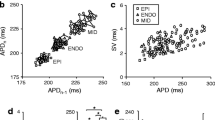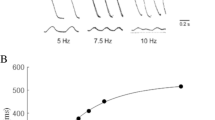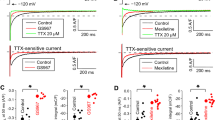Abstract
Depolarization-induced automaticity (DIA) of cardiomyocytes is the property of those cells to generate pacemaker cell-like spontaneous electrical activity when subjected to a depolarizing current. This property provides a candidate mechanism for generation of pathogenic ectopy in cardiac tissue. The purpose of this study was to determine the biophysical mechanism of DIA in terms of the ion conductance properties of the cardiomyocyte membrane. First, we determined, by use of the conventional whole-cell patch-clamp technique, the membrane conductance and DIA properties of ventricular cardiomyocytes isolated from adult rat heart. Second, we reproduced and analysed DIA properties by using an adapted version of the experimentally based mathematical cardiomyocyte model of Pandit et al. (Biophys J 81:3029–3051 2001, Biophys J 84:832–841 2003) and Padmala and Demir (J Cardiovasc Electrophysiol 14:990–995 2003). DIA in 23 rat cardiomyocytes was a damped membrane potential oscillation with a variable number of action potentials and/or waves, depending on the strength of the depolarizing current and the particular cell. The adapted model was used to reconstruct the DIA properties of a particular cardiomyocyte from its whole-cell voltage-clamp currents. The main currents involved in DIA were an L-type calcium current (I CaL) and a slowly activating and inactivating Kv current (I ss), with linear (I B) and inward rectifier (I K1) currents acting as background currents and I Na and I t as modulators. Essential for DIA is a sufficiently large window current of a slowly inactivating I CaL combined with a critically sized repolarizing current I ss. Slow inactivation of I ss makes DIA transient. In conclusion, we established a membrane mechanism of DIA primarily based on I CaL, I ss and inward rectifier properties; this may be helpful in understanding cardiac ectopy and its treatment.






Similar content being viewed by others
Abbreviations
- AP:
-
Action potential
- APD:
-
Action potential duration at half height
- CC:
-
Current clamp
- DIA:
-
Depolarization-induced automaticity
- EAD:
-
Early afterdepolarization
- LVMC:
-
Left ventricular cardiomyocyte
- P model:
- PP model:
-
P model upgraded by Padmala and Demir (2003)
- PPYM model:
-
PP model upgraded by Ypey and van Meerwijk
- RMP:
-
Resting membrane potential
- RVMC:
-
Right ventricular cardiomyocyte
- VC:
-
Voltage clamp
- V m :
-
Membrane potential
References
Askar SF, Ramkisoensing AA, Schalij MJ et al (2011) Antiproliferative treatment of myoblasts prevents arrhythmias in vitro by limiting myofibroblast-induced depolarization. Cardiovasc Res 90:295–304
Bers DM, Grandi E (2009) Calcium/calmodulin-dependent kinase II regulation of cardiac ion channels. J Cardiovasc Pharmacol 54:180–187
Cornelisse LN (2004) Excitability and calcium signaling. Chpt 5, Ph.D. thesis, Radboud University Nijmegen http://dare.ubn.kun.nl/handle/2066/19428
Gautier P, Guillemare E, Marion A, Bertrand JP, Tourneur Y, Nisato D (2003) Electrophysiological characterization of Dronedarone in guinea pig ventricular cells. J Cardiovasc Pharmacol 41:191–202
Gray RA, Huelsing DJ (2008) Excito-oscillatory dynamics as a mechanism of ventricular fibrillation. Heart Rhythm 5:575–584
Hume J, Katzung BG (1980) Physiological role of endogenous amines in the modulation of ventricular automaticity in the guinea-pig. J Physiol 309:275–286
Katzung B (1974) Electrically induced automaticity in ventricular myocardium. Life Sci 14:1133–1140
Katzung BG, Hondeghem LM, Grant AO (1975) Cardiac ventricular automaticity induced by current of injury. Pflügers Arch 360:193–197
Padmala S, Demir SS (2003) Computational model of the ventricular action potential in adult spontaneously hypertensive rats. J Cardiovasc Electrophysiol 14:990–995
Pandit SV, Clark RB, Giles WR, Demir SS (2001) A mathematical model of action potential heterogeneity in adult rat left ventricular myocytes. Biophys J 81:3029–3051
Pandit SV, Giles WR, Demir SS (2003) A mathematical model of the electrophysiological alterations in rat ventricular myocytes in type-I diabetes. Biophys J 84:832–841
Pogwizd SM, Bers DM (2004) Cellular basis of triggered arrhythmias in heart failure. Trends Cardiovasc Med 14:61–66
Salle L, Kharche S, Zhang H, Brette F (2008) Mechanisms underlying adaptation of action potential duration by pacing rate in rat myocytes. Prog Biophys Mol Biol 96:305–320
Shimoni Y, Firek L, Giles W (1994) Short-term diabetes alters K+ currents in rat ventricular myocytes. Circ Res 74:620–628
Shimoni Y, Severson D, Giles W (1995) Thyroid status and diabetes modulate regional differences in potassium currents in rat ventricle. J Physiol 488:673–688
Tran DX, Sato D, Yochelis A, Weiss JN, Garfinkel A, Qu Z (2009) Bifurcation and chaos in a model of cardiac early afterdepolarizations. Phys Rev Lett 102:258103 (Epub 2009 June 25)
Umar S, de Visser YP, Steendijk P et al (2009) Allogenic stem cell therapy improves right ventricular function by improving lung pathology in rats with pulmonary hypertension. Am J Physiol 297:H1606–H1616
Umar S, Lee J-H, de Lange E et al (2012) Spontaneous ventricular fibrillation in right ventricular failure secondary to chronic pulmonary hypertension. Circ Arrhythm Electrophysiol 5:181–190
Wagner MB, Kumar R, Joyner RW (2004) Induced automaticity in isolated rat atrial cells by incorporation of a stretch-activated conductance. Pflügers Arch 447:819–829
Weiss JN, Garfinkel A, Karagueuzian HS, Chen PS, Qu Z (2010) Early afterdepolarizations and cardiac arrhythmias. Heart Rhythm 7:1891–1899
Zeng J, Rudy Y (1995) Early afterdepolarizations in cardiac myocytes: mechanism and rate dependence. Biophys J 68:949–964
Acknowledgments
We thank Dr Pandit (University of Michigan, USA) for his kind help in correcting a few misprints in the published model equations (2001). We acknowledge Dr A. Baartscheer (University of Amsterdam) for his advice on rat cardiomyocyte dissociation procedure.
Author information
Authors and Affiliations
Corresponding author
Electronic supplementary material
Below is the link to the electronic supplementary material.
Rights and permissions
About this article
Cite this article
Ypey, D.L., van Meerwijk, W.P.M., Umar, S. et al. Depolarization-induced automaticity in rat ventricular cardiomyocytes is based on the gating properties of L-type calcium and slow Kv channels. Eur Biophys J 42, 241–255 (2013). https://doi.org/10.1007/s00249-012-0866-9
Received:
Revised:
Accepted:
Published:
Issue Date:
DOI: https://doi.org/10.1007/s00249-012-0866-9




